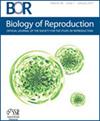CCDC188 缺失会导致小鼠精子头颈部连接缺陷,从而导致雄性不育
IF 3.1
2区 生物学
Q2 REPRODUCTIVE BIOLOGY
引用次数: 0
摘要
无头精子症(ASS)是一种罕见的遗传和生殖疾病,其定义是精液中大部分为无头精子。精子颈部的连接件又称头尾连接装置(HTCA),在精子头部和尾部的紧密连接中起着至关重要的作用。该结构的功能障碍会导致精子头尾分离,造成男性不育。以小鼠为实验模型,已经确定了几种与 HTCA 相关的蛋白质,破坏这些蛋白质会导致无头精子症。然而,这种形态异常和 HTCA 的分子机制仍未确定。在本研究中,我们重点研究了含有卷曲盘旋结构域的 188(Ccdc188),它在睾丸中的表达丰富。为了阐明 CCDC188 的生理作用,我们利用 CRISPR/Cas9 系统生成了一个基因敲除(KO)小鼠系。Ccdc188 KO 雄性小鼠不育,这表明 CCDC188 对雄性生育能力不可或缺。大多数 Ccdc188 基因无效精子都是畸形精子。透射电子显微镜显示,虽然精子HTCA在没有CCDC188的情况下也能正常组装,但在精子形成过程中,HTCA未能附着在细胞核上,导致精子头颈分离。此外,我们还发现附睾尾部几乎所有的精子都缺乏线粒体鞘。综上所述,我们证明了 CCDC188 在形成紧密的精子头颈连接中起着至关重要的作用。本文章由计算机程序翻译,如有差异,请以英文原文为准。
Loss of CCDC188 causes male infertility with defects in the sperm head–neck connection in mice
Acephalic spermatozoa syndrome (ASS) represents a rare genetic and reproductive disease, which is defined as semen composed of mostly headless spermatozoa. The connecting piece in the neck region, also known as the head-to-tail coupling apparatus (HTCA), plays a crucial role in the tight linkage between the sperm head and tail. Dysfunction of this structure can lead to separation of sperm heads and tails, and male infertility. Using the mouse as an experimental model, several proteins have been identified as associated with the HTCA and disruption of these proteins causes acephalic spermatozoa. However, the molecular mechanism underlying this morphologic anomaly and HTCA remains elusive. In this study, we focused on coiled-coil domain containing 188 (Ccdc188), which shows testis-enriched expression. To elucidate the physiological role of CCDC188, we generated a knockout (KO) mouse line using the CRISPR/Cas9 system. Ccdc188 KO male mice were sterile, indicating that CCDC188 is indispensable for male fertility. Most Ccdc188-null spermatozoa were acephalic. Transmission electron microscopy revealed that while the sperm HTCA could assemble properly without CCDC188, the HTCA failed to attach to the nucleus during spermiogenesis, leading to sperm head and neck separation. In addition, we found almost all of the spermatozoa in the cauda epididymis lacked a mitochondrial sheath. Taken together, we demonstrated that CCDC188 plays a crucial role in forming a tight sperm head–neck junction.
求助全文
通过发布文献求助,成功后即可免费获取论文全文。
去求助
来源期刊

Biology of Reproduction
生物-生殖生物学
CiteScore
6.30
自引率
5.60%
发文量
214
审稿时长
1 months
期刊介绍:
Biology of Reproduction (BOR) is the official journal of the Society for the Study of Reproduction and publishes original research on a broad range of topics in the field of reproductive biology, as well as reviews on topics of current importance or controversy. BOR is consistently one of the most highly cited journals publishing original research in the field of reproductive biology.
 求助内容:
求助内容: 应助结果提醒方式:
应助结果提醒方式:


